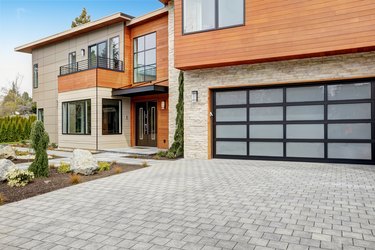A garage door that pops open only when you are standing in front of it is annoying. It can lead to late departures if you realize that you haven't closed the garage when you get to the bottom of the driveway or stops mid-way at the worst time. Depending on the type of technology and when the mechanism was made, there are many ways to make adjustments to a Chamberlain garage door opener. Although many openers are self-adjusting, there are ways to tinker with the travel and level the limit so the control works properly.

Video of the Day
Limit or Travel Adjustments
The limit adjustment settings control the points where the door will stop in its descent, up or down. A flathead screwdriver is all that is needed to make a limit adjustment on most garage door openers.
Video of the Day
If the door won't stay open to its full extent or doesn't close flush to the ground, the travel control needs an adjustment. If the up travel isn't functioning properly, turn the "up" limit adjustment screw clockwise. To decrease it, turn it counterclockwise. In order to increase the down travel, rotate the "down" limit adjustment screw counterclockwise. Move it the opposite way to decrease it. Every complete turn equals 2 inches of travel.
Testing Automatic Reverse and Safety Protector
Whenever adjustments are made, make sure to test the protector system as well as the safety reversal system. Place a roll of paper towels in the path of the door and press the button to have the door close. If the cardboard tube in the middle of the full roll of paper towels bends, then too much force is being used to reverse the door. A 2-by-4 piece of wood or 2-inch block can also reveal if the reverse is using too much force. If the garage door does not go into reverse mode immediately upon hitting the block of wood, then the door is using too much force to reverse.
The photo eye that keeps the door from closing when interrupted may need some maintenance throughout the year. This will ensure that the door will not injure small animals or children who run under the door as it is closing. Check the eye and clean it off of dust, gunk and debris that can get into the nooks of the mechanism. If the eyes mounted on each side of the garage door get bumped, they need to be realigned in order to read each other across the base of the door. To test it, block the eye and test to see if the door closes, which it should not.
Safety and Tips
Although a garage door is a daily convenience, be careful not to overlook its potential to cause damage or injury when in use. Constant pressing of control buttons while you are making adjustments can cause the motor to overheat. If the motor turns itself off to prevent damage to the unit, wait a good 15 minutes before returning to the project. It's recommended that safety tests be run every month to ensure the door is operating properly, particularly if you have many wee little ones wandering in and out of the path of the door on a daily basis.